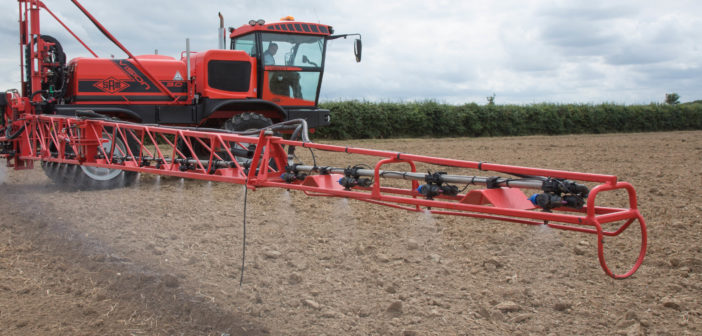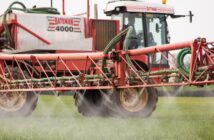Pre-emergence herbicides are the mainstay of autumn grassweed control programmes. New trials have shown how operators can maximise the efficacy of herbicide treatment through optimising their application technique – including reducing drift, according to Syngenta application specialist, James Thomas.
“With any pre-emergence it’s all about getting the maximum amount of product on the ground, with even coverage of the soil surface,” he advocated. “One of the primary issues is drift, which takes product away from the target and, by default, will reduce the overall efficacy of the treatment.”
Controllable factors James has pinpointed to help operators minimise spray drift are a combination of forward speed, boom height and nozzle choice.
James pointed out that drift risk is typically greatest with pre-emergence treatments because there is no crop to intercept and trap spray droplets. Furthermore, cooling weather conditions in the autumn frequently mean temperature differentials that can lead to warm air from the soil rising and lifting fine spray droplets up into the atmosphere, where they can be carried away even in relatively light winds.
“In reality, a proportion of the low velocity small droplets produced by flat fan nozzles may never reach the target,” he warned. “However, operators have the capability to set up their sprayer to minimise drift and, importantly, to enhance the efficacy of all pre-emergence applications.”
Speed control
“We appreciate that forward speed needs to balance work rate and accuracy. However, whilst modern sprayers with air-suspension cabs and booms are capable at operating at higher speeds, there is a direct correlation between speed and turbulence that leads to drift, especially with flat fan nozzles.”
Research has shown an increase in spray drift of 51% when the sprayer’s forward speed went from four to eight km/hr. When the speed further increased to 16 km/hr, the spray drift was increased by 144%.
This season’s application trials, at Syngenta’s Black-grass Focus Innovation Centre, at Barton in Cambridgeshire, have demonstrated a direct correlation between forward speed and grass weed control.
Spraying a pre-emergence herbicide mix, of Defy (4 l/ha) and flufenacet + diflufenican (0.6 l/ha), at 6 km/hr achieved over 80% assessed control with the pre-emergence herbicide application alone, but as speed increased control declined: to 65% at 8 km/h; 55% at 12 km/hr and 45% at 16 km/hr.
“Clearly there is a practical element of physical sprayer capacity to get around ever larger acreages in a limited time window,” James acknowledged. However, simply slowing down can have a significant beneficial effect in terms of herbicide efficacy.”
He highlighted that operators may need to look at other aspects of their system to improve sprayer output that would offset slower application, such as increasing water a storage points around the farm; efficiency of turnaround at filling points or running a bowser to pre-mix loads.
Boom height
In addition to the issues of turbulence, forward speed can also adversely affect boom stability, he pointed out. When the boom rocks, the low side will result uneven spray pattern and poor coverage, whilst the high side will be subject to excessive drift, both aspects that will lead to poor results.
“Boom height is the single biggest controllable factor in reducing drift, claimed James. “A boom at 1m will generate up to 10x the drift of a boom at the optimum 50 cm operating height.”
The Syngenta black-grass trials have again revealed the impact of application technique with boom height. At a boom height of 50 cm the Syngenta 3D Nozzle achieved over 88% control, whilst the same nozzle operated at 1 m height saw control rates fall to 70%. Flat fan nozzles operated in the same conditions produced results of 81% and 67% respectively at the two heights.
“Research has consistently shown that as boom height rises, the drift risk increases with all nozzles. With a nozzle spacing of 50 cm, a boom height of 50 cm is optimum to minimise drift and achieve best coverage of the target,” he advised.
Water volume
The comprehensive new Syngenta application trials had also looked at water volume optimisation for pre-emergence herbicide treatments. The findings were that 200 l/ha proved the most effective with all nozzle combinations, typically achieving double the control of a 50 l/ha application and a 30% better result than 100 L/ha. The Syngenta a 3D Nozzle, for example, delivered 93% assessed control at 200 l/ha, compared to 54% at 100 l/ha.
The trial also looked at applications at 400 l/ha, to assess if it would provide better coverage of the surface, but results showed no significant greater efficacy over the 200 l/ha and resulted in slower sprayer output per day at the higher water volume.
“Operators sometimes look to increase water volumes in the belief it will moisten the seedbed to improve herbicide performance. However, in reality spraying at 500 l/ha would still only equate to 0.05 mm of rainfall, not sufficient to make any difference,” added James. “We now consider that 200 l/ha is the optimum balance between product efficacy and sprayer output.”
Nozzle selection
A further factor influenced by speed and water volume would be nozzle choice, indicated James. More recently there had been a trend to smaller nozzle sizes to deliver lower water volumes at higher speeds, but with the flip that both factors are likely to increase drift.
“Smaller orifices do produce more droplets for any given water volume, however if they don’t reach the target that can be counter-productive. We have seen that larger coarser droplets, at higher velocity, hit the soil surface and spread to effectively give good coverage, particularly at the 200 l/ha water volume,†advised James.
The added advantage is that, at anything other than ideal spraying conditions, the coarser droplets of new 90% nozzles, for example, are far less susceptible to drift.
The black-grass control trials showed that a LERAP approved Teejet TTI 110-05 nozzle delivering 200 l/ha water volume, for example, achieved over 96% assessed weed control, compared to 98% with a Syngenta 3D Nozzle, even in application in good conditions
“It has really demonstrated that the 90% drift reduction nozzles are capable of achieving very high levels of pre-emergence herbicide efficacy,” he reported. Based on these comprehensive trial results, our advice for 2017 would be that, in perfect spray conditions, to use the Syngenta 3D Nozzle selected to deliver 200 //ha at 10 to 12 km/hr, at an operating pressure of 2.1 bar.
“However, if spray conditions are in anyway compromised, switch to a 90% drift reduction nozzle, typically operated at 2.0 bar and spraying at 10 km/hr.”
James concluded that key to optimising total coverage of the soil surface include
Boom height
Consistent 50cm
Forward speed
No more than 12 km/hr
Nozzle choice & Water volume
Use 90% Drift Reduction Nozzles
Apply at 200 L/ha




